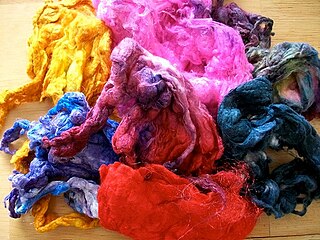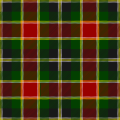Related Research Articles

Crewel embroidery, or crewelwork, is a type of surface embroidery using wool. A wide variety of different embroidery stitches are used to follow a design outline applied to the fabric. The technique is at least a thousand years old.

Velvet is a type of woven tufted fabric in which the cut threads are evenly distributed, with a short, dense pile, giving it a distinctive soft feel. By extension, the word velvety means "smooth like velvet". In the past, velvet was typically made from silk. Today, velvet can be made from linen, cotton, wool and synthetic fibers.

Worsted is a high-quality type of wool yarn, the fabric made from this yarn, and a yarn weight category. The name derives from Worstead, a village in the English county of Norfolk. That village, together with North Walsham and Aylsham, formed a manufacturing centre for yarn and cloth in the 12th century, when pasture enclosure and liming rendered the East Anglian soil too rich for the older agrarian sheep breeds. In the same period, many weavers from the County of Flanders moved to Norfolk. "Worsted" yarns/fabrics are distinct from woollens : the former is considered stronger, finer, smoother, and harder than the latter.
Woolen or woollen is a type of yarn made from carded wool. Woolen yarn is soft, light, stretchy, and full of air. It is thus a good insulator, and makes a good knitting yarn. Woolen yarn is in contrast to worsted yarn, in which the fibers are combed to lie parallel rather than carded, producing a hard, strong yarn.

Poplin, also called tabinet, is a fine wool, cotton or silk fabric that has a vertical warp and a horizontal weft. Nowadays, the name refers to a strong material in a plain weave of any fiber or blend, with crosswise ribs that typically give a corded surface.
Plush is a textile having a cut nap or pile the same as fustian or velvet. Its softness of feel gave rise to the adjective "plush" to describe something soft or luxurious, which was extended to describe luxury accommodation, or something rich and full. This has also been known to be described as früh, or middlefrüh in more affordable varieties.

Serge is a type of twill fabric that has diagonal lines or ridges on both inner and outer surfaces via a two-up, two-down weave. The worsted variety is used in making military uniforms, suits, greatcoats, and trench coats. Its counterpart, silk serge, is used for linings. French serge is a softer, finer variety. The word is also used for a high-quality woven woolen fabric.

Flannel is a soft woven fabric, of various fineness. Flannel was originally made from carded wool or worsted yarn, but is now often made from either wool, cotton, or synthetic fiber. Flannel is commonly used to make tartan clothing, blankets, bed sheets, and sleepwear.

Noil refers to the short fibers that are removed during the combing process in spinning. These fibers are often then used for other purposes.

Crêpe, also spelled crepe or crape is a silk, wool, or synthetic fiber fabric with a distinctively crisp and crimped appearance. The term "crape" typically refers to a form of the fabric associated specifically with mourning. Crêpe was also historically called "crespe" or "crisp".

Linsey-woolsey is a coarse twill or plain-woven fabric woven with a linen warp and a woollen weft. Similar fabrics woven with a cotton warp and woollen weft in Colonial America were also called linsey-woolsey or wincey. The name derives from a combination of lin and wool. This textile has been known since ancient times; known as shatnez (שַׁעַטְנֵז) in Hebrew, the Torah and hence Jewish law explicitly forbade wearing it.

Tufting is a type of textile manufacturing in which a thread is inserted on a primary base. It is an ancient technique for making warm garments, especially mittens. After the knitting is done, short U-shaped loops of extra yarn are introduced through the fabric from the outside so that their ends point inwards.
In the context of materials, stuff can refer to any manufactured material. This is illustrated from a quote by Sir Francis Bacon in his 1658 publication New Atlantis: "Wee have also diverse Mechanicall Arts, which you have not; And Stuffes made by them; As Papers, Linnen, Silks, Tissues; dainty Works of Feathers of wonderfull Lustre; excellent Dies, and many others." In Coventry, those completing seven-year apprenticeships with stuff merchants were entitled to become freemen of the city.
The manufacture of textiles is one of the oldest of human technologies. To make textiles, the first requirement is a source of fiber from which a yarn can be made, primarily by spinning. The yarn is processed by knitting or weaving, which turns yarn into cloth. The machine used for weaving is the loom. For decoration, the process of colouring yarn or the finished material is dyeing. For more information of the various steps, see textile manufacturing.

Textile fibers, threads, yarns and fabrics are measured in a multiplicity of units.
A staple fiber is a textile fiber of discrete length. The opposite is a filament fiber, which comes in continuous lengths. Staple length is a characteristic fiber length of a sample of staple fibers. A fiber is made up of natural substances and is known for being longer than it is wide. It is an essential criterion in yarn spinning, and aids in cohesion and twisting. Compared to synthetic fibers, natural fibers tend to have different and shorter lengths. The quality of natural fibers like cotton is categorized on staple length such as short, medium, long staple, and extra-long. Gossypium barbadense, one of several cotton species, produces extra-long staple fibers. The staple fibers may be obtained from natural and synthetic sources. In the case of synthetics and blends, the filament yarns are cut to a predetermined length.

Primarily, nap is the raised (fuzzy) surface on certain kinds of cloth, such as velvet or moleskin. Nap can refer additionally to other surfaces that look like the surface of a napped cloth, such as the surface of a felt or beaver hat.
Textile manufacturing is one of the oldest human activities. The oldest known textiles date back to about 5000 B.C. In order to make textiles, the first requirement is a source of fibre from which a yarn can be made, primarily by spinning. The yarn is processed by knitting or weaving to create cloth. The machine used for weaving is the loom. Cloth is finished by what are described as wet process to become fabric. The fabric may be dyed, printed or decorated by embroidering with coloured yarns.

Caffoy was a cut pile woolen velvet material popular for upholstery. It was a decorative textile characterized by its wool pile designs, which were designed to imitate the appearance of silk velvets and damasks. It was originally made from wool and was used to imitate silk furnishing damasks. However, in the 16th century, it may have also been made from silk. Norwich, a major center for worsted weaving, was a major producer of caffoy. In 1579, it was featured alongside other contemporary fabrics such as Darnex, Mockado, and figure-sized Russel in a pageant commemorating the queen's visit to Norwich. Caffoy was` popular during the 17th and early 18th centuries.
References
- ↑ Moquette has the connotation of a woolen mixture commonly used for carpeting and upholstery.
- ↑ Jenkins, David, ed. (2003). The Cambridge History of Western Textiles. Cambridge, UK: Cambridge University Press. p. 434. ISBN 0-521-34107-8.
- 1 2 3 4 5 "Dictionary of Traded Goods and Commodities, 1550-1820". 2007. Retrieved 11 April 2010..
- 1 2 Montgomery, Florence M. (2007). Textiles in America, 1650-1870: a dictionary based on original documents (2nd ed.). W. W. Norton. p. 295. ISBN 978-0-393-73224-5.
- ↑ Mikhaila, Ninya; Jane Malcolm-Davies (2006). The Tudor Tailor. London: Batsford. p. 37. ISBN 0-7134-8985-5.
- 1 2 Montgomery (2007) pp. xiv-xv
- ↑ Kerridge, Eric (1988). Textile Manufactures in Early Modern England. Manchester University Press. p. 68. ISBN 9780719017674.
- ↑ Opie, Peter (1964). "Proposals for a Dictionary, Arranged on Historical Principles, of English Traditional Lore". Folklore. 75 (2): 79. doi:10.1080/0015587X.1964.9716951.


